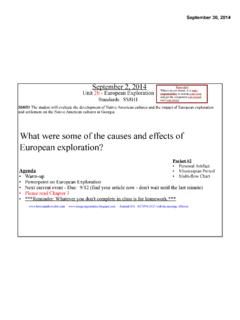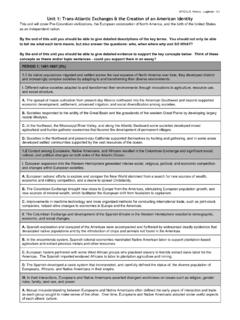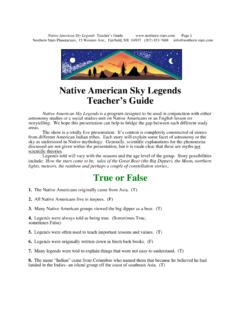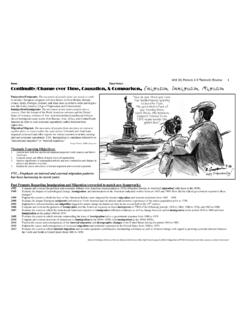Transcription of Unit III Cultural Patterns And Processes
1 unit III 1. Cultural Patterns And Processes 1. Definition of culture 1. Which statement about culture is true? A) Culture is the traditions and beliefs of a group of people. B) Culture is learned behavior that is passed from one generation to the next. C) Cultures are dynamic and always changing. D) Cultural traits are a reflection of a group s values. E) All of the above. 2. Cultural adoption 2. Which statement concerning the globalization of Western culture is true? A) Many foreign cultures have adopted Western traits like clothing and religion. B) Some areas of the world have actively resisted Western culture traits. C) Backlash against Western culture has resulted in violence in some areas. D) Western culture is often spread through movies and other media. E) All of these are true. 3. Possibilism and environmental determinism 3. The idea that an environment influences, but does not strictly determine, how a culture interacts with the environment is known as A) environmental determinism.
2 B) environmental possibilism. C) Cultural ecology. D) Cultural environmentalism. E) Cultural possibilism. 4. Cultural traits (examples in geographic context). 4. Which of the following Cultural traits is important to Americans? A) A focus on social order over individual rights. B) A strong state religion. C) Ancestor veneration and worship. D) A sense of equality and fairness. E) All of the above. 5. A single attribute of culture is called a A) culture complex. B) culture realm. C) culture landscape. D) culture hearth. E) culture trait. unit III 2. Cultural Patterns And Processes 6. A group of related Cultural traits is a A) culture complex. B) culture realm. C) culture landscape. D) culture hearth. E) culture region. 5. Cultural ecology 7. The theory that the physical environment causes social and Cultural development is called A) environmental ecology. B) Cultural ecology. C) Cultural determinism. D) environmental determinism. E) environmental landscape.
3 8. Cultural ecology is A) the study of human interaction with animals. B) the study of human attitudes towards the Cultural landscape. C) the study of environmental culture traits. D) the study of human-environment relationships. E) none of the above. 6. Cultural integration 9. The best example of Cultural integration (where all elements of society are interwoven with the dominant culture) in the United Stated is A) the upland South. B) the Mormon culture region. C) the Pacific Northwest. D) the Amish country in Pennsylvania. E) the Spanish influence in the southwest. 7. Cultural landscape 10. The idea that cultures will modify the natural landscape to fit their needs is known as the A) Cultural situation. B) Cultural landscape. C) culture traits. D) Cultural environment. E) culture building. unit III 3. Cultural Patterns And Processes 8. Cultural regions 11. The area of origin of a culture is called A) Cultural environment. B) Cultural homeland.
4 C) culture hearth. D) Cultural landscape. E) culture realm. 12. A geographic assemblage of related culture regions is A) a Cultural environment. B) a Cultural homeland. C) a culture hearth. D) a Cultural landscape. E) a culture realm. 13. Which of the following areas is not considered a Cultural realm? A) Latin America. B) Anglo America. C) Western Europe. D) New England. E) sub-Saharan Africa. 9. Formal Cultural region 14. Which of the following is an example of a formal Cultural region? A) The Rocky Mountain Region. B) The South. C) The Bible Belt. D) The Gulf Coast. E) All of the above. 10. Functional culture region 15. All of the following are examples of a functional or nodal region except A) the area served by a Walmart. B) the circulation of a daily newspaper. C) the broadcast area of a radio station. D) the area know as the South . E) any market area for a retail business. unit III 4. Cultural Patterns And Processes Vernacular culture region 16.
5 Vernacular language A) is spoken mostly by the lower class. B) has become synonymous with less education. C) has relaxed grammar rules. D) is dynamic and always changing. E) all of the above. 17. Which of the following regions is considered a vernacular culture region? A) Anglo-America. B) South America. C) The American South. D) East Asia. E) All of the above. 12. Core, periphery, domain 18. According to the Core-Domain-Sphere model A) areas in the sphere part of the model impacted most by a culture. B) influence of a culture decreases the further one travels from the core. C) influence of a culture stays the same the further one travels from the core. D) influence of a culture decreases as one travels in and around. E) all of the above. 13. Syncretism 19. Which Cultural phenomenon below is not an example of syncretism? A) Tex-Mex cuisine. B) Nordic skiing . C) Snowboarding. D) Thai cuisine. E) Japanese capitalism. 14. Cultural transition zones 20.
6 A Cultural transition zone is A) an area where cultures are divided. B) an area of great Cultural diversity. C) an area where one Cultural boundary abruptly ends and another begins. D) an area around the boundary between two culture regions that exhibits traits from both cultures. E) an area where two cultures merge into a single culture. unit III 5. Cultural Patterns And Processes 21. Which of the following areas would be considered a Cultural transition zone? A) Southwest USA-Northern Mexico. B) Southern Florida. C) Eastern Ontario-Western Quebec. D) Poland. E) All of the above. 15. Cultural diffusion 22. Cultural diffusion is A) the idea that your own culture is superior to others. B) the spread of culture traits from one group to another. C) the isolation of a culture from the rest of the world. D) the innovation of a Cultural trait. E) none of the above 23. Culture is spread by A) trans-national corporations. B) migrants. C) war and occupation.
7 D) television and other media. E) all of the above. 16. Relocation diffusion 24. Relocation diffusion is A) the rapid and widespread diffusion of a characteristic throughout the population. B) the spread of an underlying principle or idea. C) the spread of an idea from persons of power to other persons. D) the spread of an idea or trait through the physical movement of people from one place to another. E) none of the above. 25. Which of the following is an example of relocation diffusion? A) The spread of baseball to Japan. B) The spread of English to the British Colonies. C) The spread of AIDS to the United States. D) The spread of Roman Catholicism to Latin America. E) All of the above. unit III 6. Cultural Patterns And Processes 17. Expansion diffusion 26. Which of the following is not an example of expansion diffusion? A) Relocation diffusion. B) Contagious diffusion. C) Hierarchical diffusion. D) Stimulus diffusion. E) None of the above.
8 18. Contagious diffusion 27. Contagious diffusion is A) the rapid and widespread diffusion of a characteristic throughout the population. B) the spread of an underlying principle or idea. C) the spread of an idea from persons of power to other persons. D) the spread of an idea or trait through the physical movement of people from one place to another. E) none of the above. 19. Hierarchical diffusion 28. Hierarchical diffusion is A) the rapid and widespread diffusion of a characteristic throughout the population. B) the spread of an underlying principle or idea. C) the spread of an idea from persons of power to other persons. D) the spread of an idea or trait through the physical movement of people from one place to another. E) none of the above. 29. Which of the following is an example of hierarchical diffusion? A) The spread of Spanish language to Latin America. B) The spread of laptop computers from the upper class to the middle class.
9 C) The spread of AIDS from Africa to Europe. D) The spread of Wal-Mart from Arkansas to the rest of the United States. E) All of the above. 20. Stimulus diffusion 30. Studying religions is important to understanding a culture because A) religions are key to understanding the role of women in a culture. B) religions do not have any impact on the built landscape. C) each major world religion can be directly linked to a Cultural homeland. D) religious beliefs are reflected in most aspects of culture. E) all of the above. unit III 7. Cultural Patterns And Processes 31. Stimulus diffusion is A) the rapid and widespread diffusion of a characteristic throughout the population. B) the spread of an underlying principle or idea. C) the spread of an idea from persons of power to other persons. D) the spread of an idea or trait through the physical movement of people from one place to another. E) none of the above. 32. Which of the following is an example of stimulus diffusion?
10 A) The spread of English language to British colonies. B) The spread of drive-through windows from fast food restaurants to liquor stores. C) The spread of cell phones from the upper class to the middle and lower classes. D) The spread of Wal-Mart from Arkansas to the rest of the United States. E) none of the above. 21. Acculturation and assimilation 33. This is the process by which a less dominant culture adopts some of the traits of a more dominant culture. A) Cultural assimilation. B) Acculturation. C) Syncretism. D) Migrant diffusion. E) Transculturation. 34. This is the process by which a less dominant culture adopts the traits of a more dominant culture so completely that the two cultures become indistinguishable. A) Cultural assimilation. B) Acculturation. C) Syncretism. D) Migrant diffusion. E) Transculturation. 22. Distribution of languages 35. Which of these modern languages spread globally as a result of religion? A) English.








